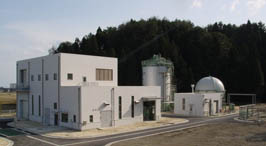Methane Fermentation Facility for Mixed Biomass Resources Delivered
Jul. 25, 2007

| Tokyo, July 25, 2007 – Kawasaki Plant Systems, Ltd. today announced that it has delivered a methane fermentation facility for biomass resources to the Suzu City Sewage Treatment Plant in Ishikawa Prefecture. This is the first biomass utilization project jointly promoted by Japan’s Ministry of Land, Infrastructure and Transport (MLIT) and the Ministry of the Environment. It is one of MLIT’s designated projects for improving the nation’s sewage systems. The facility was subsidized by the Ministry of the Environment. The methane fermentation facility is designed to treat mixed biomass resources, including sewage sludge, human waste, kitchen waste and raw fish waste discharged from seafood processing, which is Suzu City’s primary industry. Sludge is heated and dried during the process of generating biogas energy and is then used for organic fertilizer in Suzu City. The facility serves as a waste recycling system for Suzu City. The facility consists of systems for receiving and pretreating biomass resources, sludge concentration, methane fermentation, sludge dehydration, sludge drying, etc. Kawasaki received an order from Suzu City in January 2006 and was responsible for designing the entire system, providing major equipment as well as onsite construction from installation of the equipment to testing. The facility features:
|





